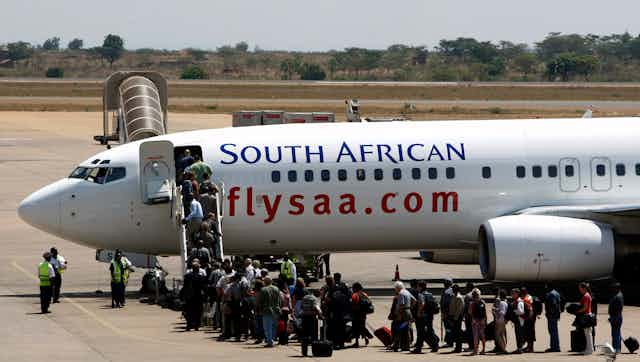South African analysts, international rating agencies and the country’s public waited with bated breath to hear Finance Minister Pravin Gordhan deliver what had been billed as his most influential budget speech to date.
Gordhan needed to deliver a budget that would address South Africa’s most pressing economic problems:
assure the nation that the looming recession could be averted. This, despite the country’s sluggish growth, high unemployment, labour market pressure as well as the myriad of other domestic factors hampering growth;
-
restore both domestic and foreign confidence in the strength and credibility of fiscal and monetary policy; and
convince ratings agency that collectively, economic and political decision makers are doing all that they can to avoid a credit downgrade.
This was never going to be an easy task and unfortunately there were many areas were Gordhan was left wanting.
The missing bits
For instance, Gordhan’s discussion on the future on state owned enterprises was an overview at best.
Simply put, there is no room in the budget for under performing entities. They are large and inefficient. The speech touched on the possibility of phasing out irrelevant entities and amalgamating others were there is overlap. But Gordhan failed to give a concrete plan on how this will be done.
Similarly, Gordhan made it clear that the objective was not to protect their monopoly power. But he didn’t give any clarity on how the government aims to support and strengthen the impartiality of the regulatory agencies so that they set prices with a clear objective of cost management and ensuring more efficient financing of investment.
On privatisation, Gordhan limited his discussion to mentioning the possibility of partial privatisation in the ports and freight rail sector. This is not surprising given that privatisation is opposed by some and is therefore seen as politically unpopular. With local elections set to take place later this year it’s understandable that he said so little.
In attempting to address the pressing issue of wasteful expenditure, Gordhan failed to provide any viable strategy. It would have been refreshing if he had made definitive and more measurable statements about cost cutting.
While Gordhan mentioned two notable cost cutting initiatives – restrictions on filling managerial and administrative positions and improvements around future procurement – these are difficult to monitor. More disconcerting was the failure to address how government plans to deal with the current levels of mismanagement.
Equally, Gordhan would have gone a long way to allay fears if he had singled out South African Airways to assure the country that the National Treasury has some degree of autonomy. And that it will not be pressured into bailing out ill performing enterprises.
The exceedingly high public sector wage bill was not addressed. Nor was the size of the cabinet, which remains a contentious issue. Even when directly asked the question at the post-budget breakfast, Gordhan refused to comment further. Instead he simply stated that constitutionally, cabinet decisions rested with the president.
This does not bode well if the country is to avert a fiscal cliff.
Not enough to avoid a downgrade
Almost all ratings agencies use similar, well-defined criteria when assigning the credit rating for a specific country. They include the level of per capita income, GDP growth, inflation, the fiscal balance, the external balance, external debt and the country’s default history.
If market reaction is anything to go by – captured by a fall in the rand immediately after the budget speech – then the budget may not have done enough to convince ratings agencies which were expecting a more austere budget that promoted investment. The most crucial deciding factors might be:
the downward revision of the growth forecast to a dismal 0.9% for 2016;
the upward revision in inflation expectations; and
recent developments, such as the withdrawal of investment by prominent companies.
Why it’s difficult to strike the right balance
In his speech Gordhan conceded that multiple demands on the nation’s strained resources are often overwhelming. Faced with these complexities, the National Treasury has to make difficult decisions.
Given the ever-present objective of reducing inequality levels, the government has to be prudent in how it prioritises spending. With the large debt burden, the avenue to raise funds through borrowing has been largely exhausted. Hence revenue streams could only be achieved through a more progressive tax system.
More social grants, coupled with tax relieve, alleviated the burden on lower-income households. Inequality was also addressed by the focus on improving public transport, health care and education as well increasing accessibility of telecommunication infrastructure to marginalised segments of society.
The budget also makes provision for infrastructure development aimed at encouraging domestic investment as well as attracting foreign investment. This will increase long-term growth. As Henry Hazlitt states:
The problem of distribution on which all the stress is being put today, is after all more easily solved the more there is to distribute. We can clarify our thinking if we put our chief emphasis where it belongs – on policies that will maximise production.
A little less talk, a little more action
Since 1994, economic decision making has been guided by a number of broad macroeconomic frameworks. Unresolved differences remain on an appropriate strategy. But the common objective has always been to promote economic growth.
In addition, South Africa has managed to build institutions that are largely sound. The challenge now rests in implementation.
The initiatives which Gordhan claimed are in progress to address policy co-ordination and implementation challenges were too broad and lacked urgency and conviction. More specifically, no specific timelines were attached.
Ultimately, since implementation is a top-down process, its success requires integrity along the entire chain of command.

